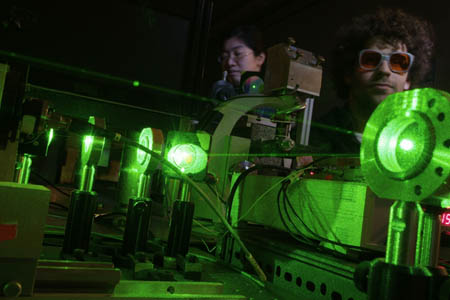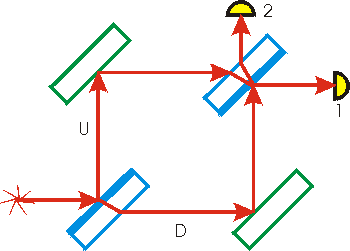- More than 2 years ago
There’s no way around it: The nature of light seems different depending on how it’s observed. Light can act like a particle or wave, and all shades of gray in between. Now, physicists have the most dramatic demonstration yet that this range of behaviors between wave and particles really is unavoidable, and that light itself doesn’t know what it is while it’s propagating.


Light is made of elementary particles called photons, but those photons don’t have well-defined trajectories. At any given time, their positions are diffused clouds of probability that move like waves. Thus, light can act like a wave, going around obstacles and creating patterns of interference. Or a photon can act like a particle, producing a discrete click when it hits a detector. The behavior depends on the experimental measurement.
In one interpretation, light somehow knows in advance what kind of measurement will be performed, so it can pick a certain modus operandi. “In a naïve interpretation, the photon would know the experimental apparatus, and behave accordingly,” says Jean-François Roch of the Ecole Normale Supérieure in Cachan, France. “If the experiment tests the particle-like behavior, then it behaves like a particle, and if the experiment tests the wavelike behavior, then it behaves like a wave.”
Roch and his collaborators, however, have now shown that this naïve interpretation is, well, naïve — and they have done so for the first time for the full range of light’s behaviors. In an upcoming Physical Review Letters , they describe randomly changing the measurement they took while light was propagating, and how light behaved accordingly.
“You can change choices which, common sense says, had to be made at the beginning,” comments Wojciech Zurek of the Los Alamos National Laboratory. “In some sense, you can rewrite the past by what you measure now.”
Inspired by an idea proposed three decades ago by physicist John Archibald Wheeler, Roch and his team played mind tricks with a single photon at a time. In their experiment, each photon went first through a partially reflecting mirror. Normally, the mirror would appear to reflect 50 percent of the light and let the other 50 percent pass through.
But a single photon, faced with the choice of going straight through the mirror or bouncing off, won’t decide right away. Only once it hits a detector will the photon decide which trajectory it took, with a 50-50 chance.
After splitting, the photons’ two virtual paths bounced off two (real) mirrors, and then crossed at a point. Beyond that point, the physicists placed a detector on each of the possible paths. Right at the crossing point, however, the researchers also placed a second partially reflecting mirror. They finely tuned the position of this last mirror to create the unmistakable signature of wavelike behavior. Light waves corresponding to the two paths created a pattern of interference — with crests and troughs reinforcing or canceling each other out.
The team arranged the second partially reflecting mirror so that it would randomly twist the waves every 10 nanoseconds or so.
Roche and his collaborators had already described this kind of experiment last year in Science , in which the mirror twisted the waves by either 0 or 90 degrees. Twisting 90 degrees made the interference disappear, as if the mirror wasn’t there, so that the experiment would revert to testing particle-like behavior. In the experiment reported in the upcoming paper, the team put into practice a variation on Wheeler’s idea, proposed by Zurek and William Wootters at WilliamsCollege in Williamstown, Mass. In the new twist, the researchers allowed intermediate angles, so the last mirror can twist the light not only by 90 degrees, but also by any intermediate angle . That let the detectors receive partial information about the photon’s path, which corresponded to the full range between particle and wave behaviors. The result is a progressive shift from interference to partial interference to no interference, showing that the particle/wave duality admits all shades of gray.
The researchers also placed the mirrors far from each other — about 50 meters apart. Because a photon takes tens of nanoseconds to cover such a distance, and because information cannot travel faster than the speed of light, each photon couldn’t possibly know the random state of the mirror —which changed faster than that –— in advance.
Peter Sonnentag of the University of Tübingen in Germany calls the team’s latest results “very convincing.” He says that such experiments rule out “an interpretation of quantum mechanics that would state that the photon adjusts its behavior to wavelike or particle-like at the beginning of an experiment.”







